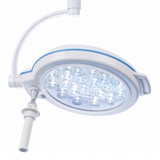The findings, published in the latest report from the National Health Performance Authority, provide the most detailed picture yet available about Australia's most frequent users of GP services.
The report, Healthy Communities: Frequent GP attenders and their use of health services in 2012–13, shows that one in eight Australians (12.5 per cent) saw a GP at least 12 times in 2012–13, accounting for 41 per cent of the $16 billion Medicare paid in out-of-hospital benefits. About one-third of this group saw five different GPs or more in that year, although some of these GPs may have been the same doctor practising in a different location.
Australians visit a GP 5.6 times per year on average, but until now there has been little publicly available information about the patients who see GPs much more often than this. Today's report release is a significant step in expanding our knowledge about this little-understood group.
The report divides the Australian population into six groups based on the number of times people visited a GP in 2012–13. The Performance Authority has focused on the two highest groups: people who visited a GP between 12 and 19 times in the year (called 'frequent GP attenders'), and those who went 20 or more times ('very high attenders').
The findings show that in 2012–13:
- Among very high GP attenders (20+ visits), three-quarters (75 per cent) were aged 45 or above, and 57 per cent were aged 60 or above. In contrast, 45 per cent of frequent GP attenders (12-19 visits) and 18 per cent of occasional attenders (4-5 visits) were aged 60 or above. Very high GP attenders were almost twice as likely as low attenders (1-3 visits) to have lived in areas of low socioeconomic status (29 per cent compared to 16 per cent)
- Among very high attenders (20+ visits), more than one-third (36 per cent) reported having three or more long-term health conditions, compared to 29 per cent of frequent attenders (12-19 visits). The figure for all Australians was just 7 per cent
- Very high and frequent GP attenders (12+ visits) accounted for about 60 per cent of the people who reported being admitted to hospital four or more times in that year. Just over 40 per cent of very high attenders (20+ visits) and 30 per cent of frequent attenders (12-19 visits) reported visiting an emergency department, compared to 10 per cent of low attenders (1-3 visits).
- Some local areas have markedly higher concentrations of very high and frequent users than other areas. Across higher-income inner-city areas, the Australian Capital Territory had the lowest population rate of people in these two groups (7.1 per cent), compared to 14.5 per cent in Inner West Sydney. Similarly, across lower-income regional areas, the range was from 8.3 per cent (New England, NSW and South West WA) to 15.3 per cent (Wide Bay, Qld)
The amount of money Medicare paid out on average for very high ($3,202) and frequent ($1,850) GP attenders varied widely from local area to local area.
National Health Performance Authority CEO Dr Diane Watson said the findings provided unprecedented insights into the characteristics of people who visit GPs most often.
"Patients who see GPs much more than the average are of interest to health and hospital managers, doctors and nurses because they have the most need for effective, well-coordinated health care," Dr Watson said.
"There will be different factors at play in each local area that may explain its mix of frequent and less frequent GP attenders. The report will give vital information to health providers in each community that may help them to better understand their unique patient populations."
The report does not suggest any number of GP visits is either too many or too few. Nor does it assess the extent to which patient needs are being met in any of the attender groups.
More information on the percentage of high and frequent GP attenders in each of 330 local areas, the report and downloadable spreadsheets are available on the Performance Authority's MyHealthyCommunities website.
To coincide with the report's release, the Performance Authority has also published on the website updated patient experience data for 2012–13 for an additional 12 measures, including Australians' visits to hospital emergency departments, waiting times for GP care, cost barriers to GP care and cost barriers to seeing a medical specialist or obtaining a prescription medicine.
















